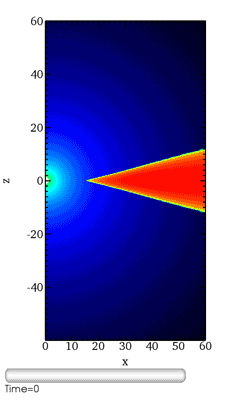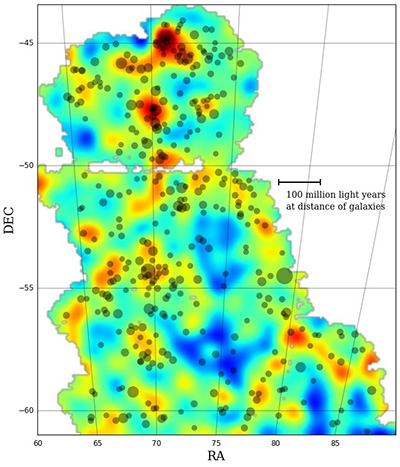搜索结果: 1-15 共查到“理学 Cosmos”相关记录21条 . 查询时间(0.093 秒)


Zwicky Transient Facility Opens Its Eyes to the Volatile Cosmos(图)
Zwicky Transient Facility Opens Its Eyes Volatile Cosmos
2017/11/24
A new robotic camera with the ability to capture hundreds of thousands of stars and galaxies in a single shot has taken its first image of the sky, an event astronomers refer to as "first light." The ...

Black holes make for a great space mystery. They're so massive that nothing, not even light, can escape a black hole once it gets close enough. A great mystery for scientists is that there's evidence ...

Mapping the cosmos: Dark Energy Survey creates detailed guide to spotting dark matter(图)
Mapping the cosmos Dark Energy spotting dark matter
2015/4/29
Scientists on the Dark Energy Survey have released the first in a series of dark matter maps of the cosmos. These maps, created with one of the world's most powerful digital cameras, are the...
AzTEC Millimetre Survey of the COSMOS Field: I. Data Reduction and Source Catalogue
starburst submillimetre
2014/12/23
We present a 1.1 mm wavelength imaging survey covering 0.3 deg2 in the COSMOS field. These data, obtained with the AzTEC continuum camera on the James Clerk Maxwell Telescope, were centred on a promin...
STAR FORMATION RATES IN LYMAN BREAK GALAXIES: RADIO STACKING OF LBGs IN THE COSMOS FIELD AND THE SUB-mu Jy RADIO SOURCE POPULATION
formation evolution
2014/12/23
We present an analysis of the radio properties of large samples of Lyman break galaxies (LBGs) at z ~ 3, 4, and 5 from the COSMOS field. The median stacking analysis yields a statistical detection of ...
The Chandra COSMOS Survey (C-COSMOS) is a large, 1.8 Ms, Chandra program that has imaged the central 0.5 deg2 of the COSMOS field (centered at 10 h , +02 o ) with an effective exposure of ~160 ks, and...
AzTEC Millimetre Survey of the COSMOS field - II. Source count overdensity and correlations with large-scale structure
galaxies submillimeter gravitational lensing
2014/12/22
We report an overdensity of bright submillimetre galaxies (SMGs) in the 0.15 deg2 AzTEC/COSMOS survey and a spatial correlation between the SMGs and the optical-IR galaxy density at z≲ 1.1. This...
THE REDSHIFT AND NATURE OF AzTEC/COSMOS 1: A STARBURST GALAXY AT z = 4.6*
broadband narrowband photometry
2014/12/20
Based on broadband/narrowband photometry and Keck DEIMOS spectroscopy, we report a redshift of z = 4.64+0.06 –0.08 for AzTEC/COSMOS 1, the brightest submillimeter galaxy (SMG) in the AzTEC/COSMOS fiel...
Modelling mid-Pliocene climate with COSMOS
Simulation model of the earth system model the transfer pliocene weather reconstruction model
2014/12/10
In this manuscript we describe the experimental procedure employed at the Alfred Wegener Institute in Germany in the preparation of the simulations for the Pliocene Model Intercomparison Project (Plio...
Full revision of“单元纯系宇宙”and "Homogenous Cosmos Originated from Unique Genesis
PNT惠合系 单元纯系宇宙
2015/6/4
作为认识历史延续,“单元纯系宇宙”是从传统科学有关“物质微观结构趋同性”认识积蓄中延伸出来的“宇宙重认识和重定义”,——源自“宇宙单元纯系假设”、关于整个宇宙构造及其宇宙物质性存在与运动变化的“单一线性逻辑体系”。它将传统科学有关“物质微观结构趋同性”认识积蓄兑现至“宇宙单元纯系假设”,继而将宇宙内涵“时空”与“物质”代入“宇宙单元纯系假设”,导出时空与物质间的纯系性“PNT关系(或PNT行为)”...
Clipping the Cosmos: The Bias and Bispectrum of Large Scale Structure
Bias Bispectrum Large Scale Structure
2011/10/21
A large fraction of the information collected by cosmological surveys is simply discarded to avoid lengthscales which are difficult to model theoretically. We introduce a new technique which enables t...
Two fossil groups of galaxies at z~0.4 in the COSMOS: accelerated stellar-mass build-up, different progenitors
X-rays: galaxies: clusters – galaxies: groups: general – galaxies: evolution – galaxies: luminosity function, mass function
2011/10/12
We report on 2 fossil groups of galaxies at z=0.425 and 0.372 discovered in the Cosmic Evolution Survey (COSMOS) area. Selected as X-ray extended sources, they have total masses (M_200) of 1.9(+/-0.41...
Probing the faint end of the quasar luminosity function at z ~ 4 in the COSMOS field
cosmology observations — quasars general — surveys
2010/11/12
We searched for quasars that are 3 mag fainter than the SDSS quasars in the redshift range 3.7 . z . 4.7 in the COSMOS field to constrain the faint end of the quasar luminosity function.
The CfAO's Astronomy Course in COSMOS: Curriculum Design, Rationale, and Application
The CfAO's Astronomy Course COSMOS Curriculum Design
2010/11/12
From 2001 to 2007, COSMOS provided a teaching and outreach venue for the Center for Adaptive Optics Professional Development Program (CfAO PDP). COSMOS is a four-week residential mathematics and scie...


